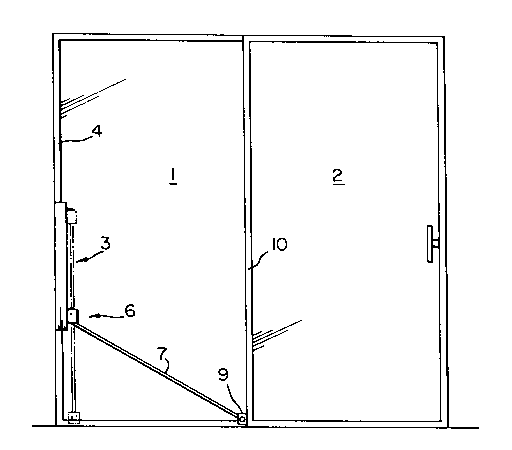Une partie des informations de ce site Web a été fournie par des sources externes. Le gouvernement du Canada n'assume aucune responsabilité concernant la précision, l'actualité ou la fiabilité des informations fournies par les sources externes. Les utilisateurs qui désirent employer cette information devraient consulter directement la source des informations. Le contenu fourni par les sources externes n'est pas assujetti aux exigences sur les langues officielles, la protection des renseignements personnels et l'accessibilité.
L'apparition de différences dans le texte et l'image des Revendications et de l'Abrégé dépend du moment auquel le document est publié. Les textes des Revendications et de l'Abrégé sont affichés :
| (12) Brevet: | (11) CA 2042475 |
|---|---|
| (54) Titre français: | DISPOSITIF DE VERROUILLAGE POUR PORTE ET FENETRE |
| (54) Titre anglais: | DOOR AND WINDOW LATCH |
| Statut: | Durée expirée - au-delà du délai suivant l'octroi |
| (51) Classification internationale des brevets (CIB): |
|
|---|---|
| (72) Inventeurs : |
|
| (73) Titulaires : |
|
| (71) Demandeurs : |
|
| (74) Agent: | |
| (74) Co-agent: | |
| (45) Délivré: | 1996-07-16 |
| (22) Date de dépôt: | 1991-05-13 |
| (41) Mise à la disponibilité du public: | 1992-11-14 |
| Requête d'examen: | 1992-10-14 |
| Licence disponible: | S.O. |
| Cédé au domaine public: | S.O. |
| (25) Langue des documents déposés: | Anglais |
| Traité de coopération en matière de brevets (PCT): | Non |
|---|
| (30) Données de priorité de la demande: | S.O. |
|---|
In general, latch devices for sliding patio doors
are complicated and/or intended to lock a door fully closed.
A simple device for latching a sliding door or window partly
or fully open or fully closed includes a track for mounting on
a frame opposite the side edge of a movable door or window
panel; a slide for slidable mounting on the track; a bracket
for mounting on the edge of the panel at the bottom thereof; a
rod pivotally connected to the slide and to the bracket; a
bolt slidable in a recess in the slide body which contains a
spring for biasing the bolt outwardly against teeth on the
track, the teeth normally permitting movement of the slide in
one direction on the track so that the door can be closed but
not opened; and a pin for insertion through the slide into the
bolt to hold the bolt retracted in the slide, so that the door
can move freely between the open and closed positions.
Note : Les revendications sont présentées dans la langue officielle dans laquelle elles ont été soumises.
Note : Les descriptions sont présentées dans la langue officielle dans laquelle elles ont été soumises.

2024-08-01 : Dans le cadre de la transition vers les Brevets de nouvelle génération (BNG), la base de données sur les brevets canadiens (BDBC) contient désormais un Historique d'événement plus détaillé, qui reproduit le Journal des événements de notre nouvelle solution interne.
Veuillez noter que les événements débutant par « Inactive : » se réfèrent à des événements qui ne sont plus utilisés dans notre nouvelle solution interne.
Pour une meilleure compréhension de l'état de la demande ou brevet qui figure sur cette page, la rubrique Mise en garde , et les descriptions de Brevet , Historique d'événement , Taxes périodiques et Historique des paiements devraient être consultées.
| Description | Date |
|---|---|
| Exigences relatives à la révocation de la nomination d'un agent - jugée conforme | 2020-09-01 |
| Inactive : Périmé (brevet - nouvelle loi) | 2011-05-13 |
| Inactive : CIB de MCD | 2006-03-11 |
| Accordé par délivrance | 1996-07-16 |
| Demande publiée (accessible au public) | 1992-11-14 |
| Exigences pour une requête d'examen - jugée conforme | 1992-10-14 |
| Toutes les exigences pour l'examen - jugée conforme | 1992-10-14 |
| Déclaration du statut de petite entité jugée conforme | 1991-05-13 |
Il n'y a pas d'historique d'abandonnement
| Type de taxes | Anniversaire | Échéance | Date payée |
|---|---|---|---|
| TM (brevet, 7e anniv.) - petite | 1998-05-13 | 1998-05-12 | |
| TM (brevet, 8e anniv.) - petite | 1999-05-13 | 1999-04-23 | |
| TM (brevet, 9e anniv.) - petite | 2000-05-15 | 2000-05-11 | |
| TM (brevet, 10e anniv.) - petite | 2001-05-14 | 2001-05-09 | |
| TM (brevet, 11e anniv.) - petite | 2002-05-13 | 2002-05-09 | |
| TM (brevet, 12e anniv.) - petite | 2003-05-13 | 2003-05-09 | |
| TM (brevet, 13e anniv.) - petite | 2004-05-13 | 2004-04-20 | |
| TM (brevet, 14e anniv.) - petite | 2005-05-13 | 2005-05-03 | |
| TM (brevet, 15e anniv.) - petite | 2006-05-15 | 2006-05-03 | |
| TM (brevet, 16e anniv.) - petite | 2007-05-14 | 2007-04-24 | |
| TM (brevet, 17e anniv.) - petite | 2008-05-13 | 2008-05-05 | |
| TM (brevet, 18e anniv.) - petite | 2009-05-13 | 2009-05-12 | |
| TM (brevet, 19e anniv.) - petite | 2010-05-13 | 2010-03-11 |
Les titulaires actuels et antérieures au dossier sont affichés en ordre alphabétique.
| Titulaires actuels au dossier |
|---|
| PIERRE VEILLETTE |
| Titulaires antérieures au dossier |
|---|
| S.O. |